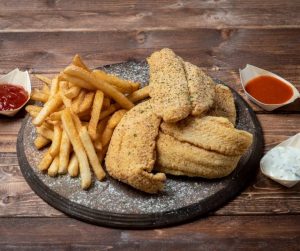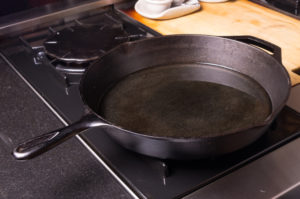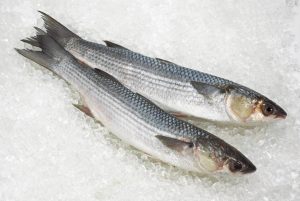Fried fish is a southern favorite for good reason. A good fish fry will bring people together and fill their bellies up too. You can have great tasting fried fish with about 5 ingredients.
So, what is fried fish? Fried fish is batter-covered fish that is deep-fried to a crispy golden exterior and a tender interior. This definition of fried fish is shared all across North America, though the batter can vary by region.
In this article, you will learn how to perfect your fish fry to your preference.
But first, let’s get pan-frying out of the way.
Whenever the term “fried fish” is used correctly, it refers to deep-fried fish primarily because pan-frying fish is closer to searing than frying.
Benefits of Deep Frying Fish
Deep-frying results in crispier fish and fries fish evenly. As a result, deep-frying is considered the primary method of frying fish.
You’ll want to use a pot or a deep pan so that the fish can be completely submerged in oil. Using a shallow pan can cause uneven cooking of the fish and could also cause the batter to fall off.
Choosing the right method is half of the battle! Applying it is the other half.

How to Make Deep-Fried Fish
To make deep-fried fish, you need to coat the fish with batter, then heat oil in a deep-fryer or a deep skillet until it reaches 350F degrees. (A deep cast iron skillet works great for frying fish.)
After that, you drop the batter-covered fish in the fryer and let it sit for about 3 minutes, taking it out it once it has the perfect golden color.
The above instructions can be a bit reductive for newbies (I have written an entire post on how to fry fish here).
If you’ve never formally learned how to fry fish and want to learn from someone who was brought up in a commercial fishing family, check out the article linked above and you’ll be frying fish like a pro.
Do You Use Batter to Fry Fish?
Coating fish with a layer of batter is standard for deep frying fish.
Frying fish without batter is, for the most part, an unheard-of practice.
This brings up the question of which batter is better. There’s the standard, “make everything taste like chicken” batter, which is just coating the fish in flour, sometimes dredging it through milk and egg first.
In the fishing towns here in the South, we prefer cornmeal batter.
Taste is a very personal thing and can shift from person to person. Still, I recommend using cornmeal batter for a new experience. If all you have is flour, that will work too.
Regardless of the batter you choose, please remember that battering requires tact too. My guide to frying fish covers different methods of battering and coating fish.

The Best Oil for Deep Frying Fish
The best oil for deep frying fish is beef tallow, which has a high smoking point, and you can fry multiple batches of fish without having to refresh the oil. You can use peanut oil for fewer batches as it doesn’t smoke easily either.
If you don’t choose the right oil, you will end up with a muffler under your nose, trying not to inhale smoke. Or even worse, you might fry fish at a lower temperature.
The oil/grease has to be 350-375 F for the fish to fry well, and certain oils can start producing smoke before that.
If the oil doesn’t produce smoke at the frying temperature and you keep frying more batches, you might eventually witness smoke at lower temperatures.
This is a sign that the oil is burnt, which can ruin the entire batch of fish.
To avoid this (and other mistakes), read this…
Most Common Fish Frying Mistakes
- Using too much batter – A thick layer of batter can overpower the taste of fish, or become too clumpy and fall off.
- Pan-frying after battering – The batter gets rubbed away when too little oil is used in a shallow frying method.
- Using the wrong oil – Cooking becomes difficult, and you are more likely to end up with under fried or over fried fish.
- Repeatedly using old oil -This can affect the taste of the fish, making it significantly more bitter due to the charred flavor of old oil.
- Frying the fish too long – While under-fried fish can be salvaged, once you over-fry fish…you ruin it forever.
- Dropping the fish in the oil before it reaches 350-375 F –The fish will turn out soggy and will take longer to fry.
As you can see from the last point, duration matters!
With the batter being just right, the fish choice being impeccable, and the oil being at the perfect temperature, you still need to get the timing right to get that ideal golden fried fish.
How Long to Fry Fish?
You should deep fry fish for 3 to 6 minutes, frying the more tender fish for up to 3 minutes and bigger fish for almost 6 minutes. I recommend using a frying thermometer and preparing a test sample.
The test sample is crucial if you’re new to fish frying, but you might not even need a timer once you get in your groove.
Generally, it is better to err on the side of frying less, but within reason. And every time you fry a different type of fish, you need to be more cautious about the frying duration.
Once the fish is floating to the top, it’s ready to be pulled out.
Everything else remains constant no matter the species of fish.
From your batter to oil choice, you can keep everything the same to prepare the perfect fried fish regardless of the fish species.

4 Products That Can Improve Your Fried Fish
Even though my guide on frying fish covers aspects like battering, frying duration, and even cleaning the grease afterward, it only covers the essentials of deep-frying fish.
There is always room to improve, and the following tools will ensure you don’t just fry fish but also get the best results.
1. Frying Thermometer
Cooking feels intuitive because we do it often, but it is ultimately a very material science. You’ll
get the best results if you use the right duration, contents, and temperature alongside the ideal cooking method.
Cooking temperature is the most decisive component of how well fish is fried, and to get the perfect fish fry, you must get a frying thermometer like the Taylor Precision Products Deep Frying Thermometer.
2. A Batter Bowl
When it comes to battering, what many see as an unnecessary expense is often a money saver.
Because of its battering and shaking functions, a batter bowl can prevent the batter from being wasted by keeping it from sticking to the container or your hands. I recommend the CanCooker Batter Bowl
You can turn the battering bowl into a breading shaker by simply shutting the bowl’s concave lid. This is a must-have because it ensures that the fish is breaded from all sides.
3. Cast Iron Skillet

This skillet is the bare-minimum requirement for frying fish because deep-frying fish in a shallow pan is risky and results in oil splashes.
Skillet frying requires more tact than a deep-fryer, but getting a deep-fryer for one dish can be unreasonable for most people.
The Lodge Cast Iron Deep Skillet is my skillet of choice for deep-frying fish as it accommodates small batches, doesn’t waste or require as much grease, and is novice-friendly.
Above all, it is versatile enough to be used for other purposes like making fried rice and pan-searing stakes.
4. Skimmer Spoons
If you use a deep-fryer, this utensil is not essential, but if you use an actual skillet to deep-fry fish, then getting skimmer spoons is highly recommended.
It saves grease and keeps the cooking area mess-free. Any skimming spoon works as long as it gets the job done.

Frying fish of different sizes, I have found King Super Skimmer Spoons to work the best for me. Their mesh strainers allow most grease/oil to be removed from the fish regardless of size.
[BONUS] Eat More Mullet Hat
This is a cap I’ve designed not just to signify one of the only types of fish keeping commercial fishing towns alive, but also to spread the word regarding the many benefits of mullet consumption.
Mullet fishing is sustainable because the species reproduces a lot, and even when lobbied by fish farms, politicians have been unable to clamp down on mullet fishing.
I used to go mullet fishing with my grandfather as a kid, and some of my fondest childhood memories are associated with mullet fishing and the fish fries that followed.
If you want to support my movement to keep mullet fishing alive and my blog to bring authentic seafood resources to the general public, you can do so by getting (and wearing) our Eat More Mullet hat.
The Best Way to Fry Fish (6 Steps)
With the fish frying essentials and recommended items out of the way, it is time to get into the fish fry that will trump every fish you have ever had.
Wild fish makes the best fish fry as long as the batter is well-made and the fish is deep-fried to golden color. Mullet, Cod, Catfish, and Trout are the best fish to fry; the farm-raised versions can be noticeably blander in taste.
Here are the steps you need to take to make the best fish fry.
Step 1 – Get the Right Fish
There is plenty of debate regarding the definitive best-tasting fish species, but there seems to be a consensus among serious seafood lovers: wild fish from an “inferior” species is better-tasting than farmed fish from a supposedly “superior” species. Only use wild caught fish when possible.
Some of the popular fish to fry among fishing towns along the Gulf Coast include:
- Popeye and Sliver Mullet
- White Trout (sand Trout)
- Ground mullet (whiting)
- Flounder
- Black Fish (triple tail)
- Puppy drum (small black drum)
- Sheepshead
- Red Snapper
- Grouper
- Redfish (red drum)
- Speckled trout

Step 2 – Cut Fish into Boneless Fillets
After you get your wild fish, you must cut it into clean, boneless strips.
This step can require different degrees of effort based on the kind of fish. Some fish have more bones than others. You can find a variety of YouTube videos on how to filet and de-bone just about any fish you can think of.
Catfish nuggets are popular among locals in the south (they’re made out of the fish’s belly). Fried catfish nuggets are one of the best meals one can experience when visiting the deep south.
Step 3 – Batter the Fish in Cornmeal
After making fillets out of the fish you intend to fry, you should douse it in cornmeal.
If you are using a battering shaker, you can batter it from all sides. Otherwise, you must flip the fillet to get it thoroughly breaded on both sides.
*Pro Tip- Mix cracker meal and corn meal into 50/50 mixture to make a fish batter that will give your fried fish the perfect crunch.
Step 4 – Pour Oil into a Skillet and Heat It to 350F Degrees
This step has been covered in standard fish frying instructions in my article elsewhere, and the specifics don’t change whether the fish is being fried whole or is filleted.
First, heat the oil until your frying thermometer reads 350F degrees.
Then, you should drop a pinch of batter and see if it immediately turns into a fritter. If it does, the oil is ready for the fillet.
Step 5 – Fry the Fish for 3-6 Minutes
Drop the fish in carefully so there is no splash.
(After this is the hard part…)
You have to do nothing.
Three minutes is a long time to do nothing!
And you can’t afford to get distracted by social media because you don’t want to over cook your filets!
You will easily exceed the six-minute frying duration limit if you aren’t watching the timer and paying attention to the fish.
Step 6 – Retrieve and Serve
The final step is to get the fish out from the skillet and onto a plate covered in paper towels to soak up the excess oil.
This step is pretty easy with a skimmer spoon that can fetch the fish fillet because it can be used to strain the oil before the fillets are plated. After that, all you need to do is serve it and enjoy it.
The Best Sauces For a Fish Fry
Fish fries are best served with a variety of dipping sauces. In my experience, ketchup, cocktail, tarter, and remoulade are the best standard dipping sauces for a fish fry.
I make my own sauce from mayo, ketchup, horseradish, and hot sauce, but you may love it just the way it is.
The Best Sides For a Fish Fry

Sides are essential to any fish fry and there are a variety of sides you can serve with fried fish. Some of the best sides to go with fried fish are:
- Baked Beans
- Cole Slaw
- French Fries
- Hushpuppies
- Mac’n’cheese
- Fried Okra
These are just a few sides that can go with your fish fry.
Cook with Friends and Family
At the end of the day, fried fish is just as it sounds- fish covered in batter and deep fried, and man is it delicious!
Eating fried fish is a large part of southern culture and it always seems to bring people together.
Fried fish is a whole experience in itself because you can catch the fish, clean the fish, cook the fish, and eat it all on the same day.
This is a whole experience you can include friends and family with and it will create lifelong memories for everyone involved.

